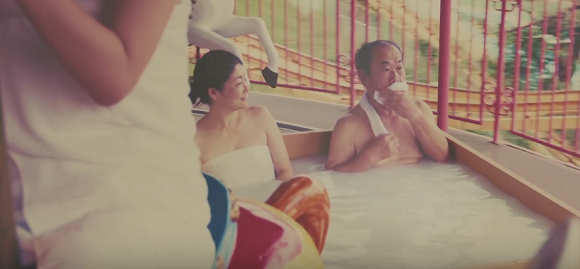Come for the retro architecture, stay for the bath and swimming pool filled with onsen hot spring water!
hot springs (Page 8)
Experience the thrill of dancing with a crowd in the bathtub without disturbing the neighbours.
Travelers have been visiting Beppu for its natural baths for years, but now the onsen is coming to them instead.
One of the most magical events of the season combines traditional bathing with the iconic blossoms of spring.
The Mayor of Beppu is delivering on his promise of a hot spring amusement park with tickets, fireworks and home-delivered onsen water for patrons.
Whether you’re a backpacker looking to clean yourself up or just want to experience this aspect of traditional Japanese culture, hundreds of options are at your fingertips.
Before bathing? After bathing? As soon as you arrive? Or not at all? Find out when most people usually change into yukata when staying at a ryokan.
The mayor who pledged to create an onsen amusement park if his video received a million views now has another message for the public.
The clip shows a number of jaw-dropping ideas for the spa-filled amusement park, including onsen carousels and roller coasters filled with spring water.
This Rakuten Travel list has us packing our tiny towels, ready for an onsen-focused vacation.
Tattooed guests are often turned away at the door at many Japanese hot springs, but a Chiba-area hot spring location is explicitly allowing guests with tattoos, and it’s a multi-floor relaxation paradise to boot!
At this enlightened facility, the management would rather people gaze at Mt. Fuji than worry about their fellow bathers’ body art.



















 Starbucks Japan ready to get Year of the Horse started with adorable drinkware and plushies【Pics】
Starbucks Japan ready to get Year of the Horse started with adorable drinkware and plushies【Pics】 Hello Kitty Choco Egg figures are an adorable trip through three periods of Japanese pop culture【Pics】
Hello Kitty Choco Egg figures are an adorable trip through three periods of Japanese pop culture【Pics】 We found possibly the quietest Japanese-style hotel in Tokyo’s bustling Shinjuku district
We found possibly the quietest Japanese-style hotel in Tokyo’s bustling Shinjuku district Sumo Sanrio! Hello Kitty and pals team up with Japan Sumo Association for new merch【Pics】
Sumo Sanrio! Hello Kitty and pals team up with Japan Sumo Association for new merch【Pics】 7 great places to see Mt. Fuji from without having to climb it
7 great places to see Mt. Fuji from without having to climb it Japanese thug wear from Birth Japan perfect for those breaking bad next year
Japanese thug wear from Birth Japan perfect for those breaking bad next year New Jimmy Choo x Sailor Moon collaboration brings anime magic to bags, shoes and accessories
New Jimmy Choo x Sailor Moon collaboration brings anime magic to bags, shoes and accessories Real-life Spirited Away train line found in Japan?
Real-life Spirited Away train line found in Japan? 7-Eleven Japan’s ramen-cooking robot whipped us up a bowl of noodles【Taste test】
7-Eleven Japan’s ramen-cooking robot whipped us up a bowl of noodles【Taste test】 Is it rude to sing along at concerts in Japan? We ask a pro musician for his take
Is it rude to sing along at concerts in Japan? We ask a pro musician for his take Disillusionment at Tsukiji’s tourist-target prices led us to a great ramen restaurant in Tokyo
Disillusionment at Tsukiji’s tourist-target prices led us to a great ramen restaurant in Tokyo Japan may add Japanese language proficiency, lifestyle classes to permanent foreign resident requirements
Japan may add Japanese language proficiency, lifestyle classes to permanent foreign resident requirements Lacquerware supplier to emperor of Japan and Pokémon team up for new tableware
Lacquerware supplier to emperor of Japan and Pokémon team up for new tableware Starbucks Japan releases new zodiac chilled cup drink for 2026
Starbucks Japan releases new zodiac chilled cup drink for 2026 Cyberpunk anime meets traditional culture in Ghost in the Shell gold leaf Japanese changing screens
Cyberpunk anime meets traditional culture in Ghost in the Shell gold leaf Japanese changing screens Japan’s otoshidama tradition of giving kids money at New Year’s gets a social welfare upgrade
Japan’s otoshidama tradition of giving kids money at New Year’s gets a social welfare upgrade Japan’s human washing machines will go on sale to general public, demos to be held in Tokyo
Japan’s human washing machines will go on sale to general public, demos to be held in Tokyo 7-Eleven Japan starts new temporary luggage storage service in over 300 branches
7-Eleven Japan starts new temporary luggage storage service in over 300 branches Starbucks teams up with 166-year-old Kyoto doll maker for Year of the Horse decorations【Photos】
Starbucks teams up with 166-year-old Kyoto doll maker for Year of the Horse decorations【Photos】 Tokyo considering law requiring more trash cans following litter increase in heavily touristed area
Tokyo considering law requiring more trash cans following litter increase in heavily touristed area Tokyo’s Tsukiji sushi neighborhood asks tour groups to stay away for the rest of the month
Tokyo’s Tsukiji sushi neighborhood asks tour groups to stay away for the rest of the month Nintendo’s Kirby now delivering orders at Kura Sushi restaurants, but not in Japan
Nintendo’s Kirby now delivering orders at Kura Sushi restaurants, but not in Japan Tokyo event lets you travel back in time, for free, to celebrate 100 years since Showa era start
Tokyo event lets you travel back in time, for free, to celebrate 100 years since Showa era start Sanrio theme park in Japan announces plans to expand into a Sanrio resort
Sanrio theme park in Japan announces plans to expand into a Sanrio resort Stamina-destroying “Paralysis Noodles” are Tokyo’s newest over-the-top ramen innovation
Stamina-destroying “Paralysis Noodles” are Tokyo’s newest over-the-top ramen innovation Survey asks foreign tourists what bothered them in Japan, more than half gave same answer
Survey asks foreign tourists what bothered them in Japan, more than half gave same answer Japan’s deadliest food claims more victims, but why do people keep eating it for New Year’s?
Japan’s deadliest food claims more victims, but why do people keep eating it for New Year’s? We deeply regret going into this tunnel on our walk in the mountains of Japan
We deeply regret going into this tunnel on our walk in the mountains of Japan Studio Ghibli releases Kodama forest spirits from Princess Mononoke to light up your home
Studio Ghibli releases Kodama forest spirits from Princess Mononoke to light up your home Major Japanese hotel chain says reservations via overseas booking sites may not be valid
Major Japanese hotel chain says reservations via overseas booking sites may not be valid Put sesame oil in your coffee? Japanese maker says it’s the best way to start your day【Taste test】
Put sesame oil in your coffee? Japanese maker says it’s the best way to start your day【Taste test】 No more using real katana for tourism activities, Japan’s National Police Agency says
No more using real katana for tourism activities, Japan’s National Police Agency says The top 10 annoying foreign tourist behaviors on trains, as chosen by Japanese people【Survey】
The top 10 annoying foreign tourist behaviors on trains, as chosen by Japanese people【Survey】 Starbucks Japan reveals new sakura drinkware collection, inspired by evening cherry blossoms
Starbucks Japan reveals new sakura drinkware collection, inspired by evening cherry blossoms Japanese thug wear from Birth Japan perfect for those breaking bad next year
Japanese thug wear from Birth Japan perfect for those breaking bad next year New Jimmy Choo x Sailor Moon collaboration brings anime magic to bags, shoes and accessories
New Jimmy Choo x Sailor Moon collaboration brings anime magic to bags, shoes and accessories Real-life Spirited Away train line found in Japan?
Real-life Spirited Away train line found in Japan? 7-Eleven Japan’s ramen-cooking robot whipped us up a bowl of noodles【Taste test】
7-Eleven Japan’s ramen-cooking robot whipped us up a bowl of noodles【Taste test】 Is it rude to sing along at concerts in Japan? We ask a pro musician for his take
Is it rude to sing along at concerts in Japan? We ask a pro musician for his take Looking for baby names? The most popular ones in Japan this year are…
Looking for baby names? The most popular ones in Japan this year are… McDonald’s and KFC Japan release new Tsukimi “moon-viewing” burgers for 2020
McDonald’s and KFC Japan release new Tsukimi “moon-viewing” burgers for 2020 Delicious fried chicken or adorable puppies? You decide
Delicious fried chicken or adorable puppies? You decide Sakura Pizza from Domino’s Pizza Japan is here, but is it any good?【Taste test】
Sakura Pizza from Domino’s Pizza Japan is here, but is it any good?【Taste test】 Over 700 photos of men undressing! Because what manga artist doesn’t draw half-naked men, right?
Over 700 photos of men undressing! Because what manga artist doesn’t draw half-naked men, right? Fujisan View Express: A train journey to Mt Fuji so stylish you’ll never want it to end
Fujisan View Express: A train journey to Mt Fuji so stylish you’ll never want it to end A guide to visiting Sagamiko Illumination, one of the three biggest light-ups in Kanto
A guide to visiting Sagamiko Illumination, one of the three biggest light-ups in Kanto